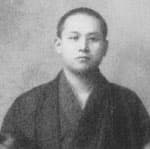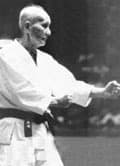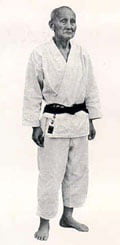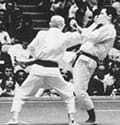The History Of Wado Ryu Karate
Sensei Hironori Ohtsuka (1892 - 1982)
 Hironori Ohtsuka, the founder of Wado-Ryu Karate-Do, was born on June 1st, 1892 in Shimodate, Ibaragi Prefecture. At the age of five years old, on the advice of his Grandmother, he started to study the art of JuJitsu. His first lessons were from his Grandfather, Chojiro Ehashi of the Clan Tsuchiura, under his study the young Ohtsuka learnt the art of Tsuki, (punching), Keri (kicks), and Nagewaza (throwing).
Hironori Ohtsuka, the founder of Wado-Ryu Karate-Do, was born on June 1st, 1892 in Shimodate, Ibaragi Prefecture. At the age of five years old, on the advice of his Grandmother, he started to study the art of JuJitsu. His first lessons were from his Grandfather, Chojiro Ehashi of the Clan Tsuchiura, under his study the young Ohtsuka learnt the art of Tsuki, (punching), Keri (kicks), and Nagewaza (throwing).
When he was thirteen years old Ohtsuka joined the Shinto-Yoshin-Ryu School of JuJitsu, under it's third Grandmaster, Shizaburo Nakayama. After entering Waseda University in Tokyo he continued to gain experience in Shinto-Yoshin-Ryu whilst also practicing with other styles of JuJitsu. Such was Ohtsuka's talents in Shinto-Yoshin-Ryu that when he visited the various Dojo (training halls) of the other JuJitsu styles, many challenges of Hon-Gumite (real fighting) were proposed. Ohtsuka gained vast experiences from these sessions, which served to rapidly increase his skills in the various techniques of JuJitsu.
In June 1920, aged 29, he completed all the lessons and was awarded the license of the highest degree in Shinto-Yoshin-Ryu, which allowed him to become the 4th Grandmaster, succeeding Sensei Nakayama. This license proved he was a true Master and he received the award of Menkyu Kaiden.
Ohtsuka attended a demonstration of Okinawan Tode (the forerunner of Karate), in July 1922 at the Meisei Juku in Tokyo. The demonstration was given by Gichin Funokoshi, a Shuri-Te exponent who later founded the Shotokan style of Karate. Ohtsuka became a student of Gichin Funokoshi.
 Such was Ohtsuka's progress in Karate that after one years training with G. Funokoshi, he was entrusted with the title Shihan Dai, (Vice Chief Instructor). Ohtsuka's insatiable thirst for Martial Arts knowledge took him to various Dojo where he exchanged techniques with other Sensei (Teachers) from Okinawa, two of the most prolific being, Choki Motobu, (Motobu-Ryu), and Kensei Mabuni, (Shinto-Ryu).
Such was Ohtsuka's progress in Karate that after one years training with G. Funokoshi, he was entrusted with the title Shihan Dai, (Vice Chief Instructor). Ohtsuka's insatiable thirst for Martial Arts knowledge took him to various Dojo where he exchanged techniques with other Sensei (Teachers) from Okinawa, two of the most prolific being, Choki Motobu, (Motobu-Ryu), and Kensei Mabuni, (Shinto-Ryu).
By 1924, Ohtsuka had developed many Yakusoko Kumite, (pre-arranged fighting techniques) he also developed Idori-No-Kata, (kneeling defence), Tachi-Ai-No-Kata and Shirahatori-No-Kata (nine defences against long sword). Studying deeper into the Okinawan Kata (forms) he found the explanation of some of the techniques hard to comprehend.
At the age of 37, 1929 was to be a very important year for him. Drawing heavily upon his knowledge of JuJitsu he merged the two arts of Shinto-Yoshin-Ryu and Okinawa-Te and founded his own School Wado-Ryu Karate Jutsu and Wado Ryu Jujutsu Kenpo.
1934 was the year in which Ohtsuka registered his school with the Dai Nippon Budo Kukai, which was an association created by the Japanese Government in 1895 to oversee Martial Arts.
 He was also awarded the title "Renshi" by the same association. At about this time he started learning Yagyu Shinkage Ryu Kenjutsu from Gihachiro Kubo, the 9th Grandmaster of the Tosa Clan.
He was also awarded the title "Renshi" by the same association. At about this time he started learning Yagyu Shinkage Ryu Kenjutsu from Gihachiro Kubo, the 9th Grandmaster of the Tosa Clan.
In 1940 the Butokai held a Budo Festival and each Ryu (school), had to register its name and the name of its founder. Ohtsuka first thought of calling his style "Shinshu Wado-Ryu" but he was advised by G. Kubo of Yagyu Shinkage Ryu to drop "Shinshu' and simply call it "Wado-Ryu", as he felt the name was repetitious (Shinshu is a rather overly patriotic name for Japan and sounds strange in the modern generation, and although the "Wa" of Wado Ryu means "peace and harmony", the word "Wa" is often used to mean "Japan"). Ohtsuka was also awarded the title of Tasshi (Kyoshi-Go).
In 1944 the Dai Nippon Buto Kukai asked Ohtsuka to become it's Chief Karate Instructor for Japan. Just as Judo emerged from Jujitsu and Kendo from Kenjutsu, Ohtsuka also felt Karate should develop from a Jutsu form to a "Do" (way or path) form and include the element of sport. The first All Japan Wado-Ryu Championships were held in 1955. In the early 1960's Ohtsuka dispatched a small number of his top students to spread the art of Wado-Ryu throughout the world.
He was awarded "Kun Goto Soukuo Kyoujujiso Sho" (comparable to the O.B.E.), from Emperor Hirohito in 1966 for his dedication to the introduction and teaching of Karate. In the late 1960's Wado-Ryu developed at a very rapid rate until the present day, where it is now the most practiced style of Karate-Do in the World.
The year of 1972 saw Higashi-Nokuni-Nomiya, (a member of the Royal Family and President of the Kokusai Budo Renmei) award Hironori Ohtsuka the title of "Meijin" the ultimate title in Martial Arts. He was the first man in the history of Karate to receive this great honour.
In November 1981 Hironori Ohtsuka abdicated his position as Grandmaster and nominated his eldest Son, Jiro Ohtsuka as the second Grandmaster, (Jiro also took on the family name to become Hironori Ohtsuka II).
 The rare picture on the left shows Hironori Ohtsuka defending from a front kick attack by his son, Jiro Ohtsuka. Taken in 1975, Ohtsuka (Snr) was 83 years old.
The rare picture on the left shows Hironori Ohtsuka defending from a front kick attack by his son, Jiro Ohtsuka. Taken in 1975, Ohtsuka (Snr) was 83 years old.
On the 29th January 1982, just four months short of his 90th birthday, Hironori Ohtsuka passed away.
In the intervening years, Wado-Ryu has continued to establish itself as one of the most practiced karate systems in the world, due to the diligence of world class instructors (such as Hironori Ohtsuka II and Tatsuo Suzuki) and the hard work of millions of practitioners and black belts world wide.
Accomplished people are often referred to as having a lifetime of experience in their particular field of endeavour - in Ohtsuka Sailo Shihan's case even this description seems slightly inadequate. His Martial Arts experience spanned 84 years of deep involvement.
Hironori Ohtsuka was truly a "Giant" in the World of Martial Arts.
 The true purpose of 'Budo' is the search for truth.
The true purpose of 'Budo' is the search for truth.
In Karate three elements are important - Physical Strength, Spirit and Heart.
The end of 'Do' (the Way), cannot be achieved in a few years, rather it is a lifelong search.
Perhaps you could say the aim is to make us good Human Beings.
